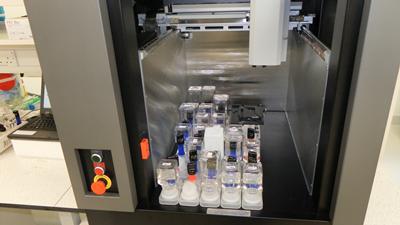The facility aims to ease entry into the crystallisation process. It offers all steps from performing the initial crystallisation experiment through to checking for success by automated imaging of crystallisation trials to identify crystal growth. Currently the facility is planning to introduce light scattering techniques as a quality assessment on submitted samples.

Supported mode of operation
Users with the University of Southampton access the facility by providing a purified or synthesised sample of a macromolecule. They can then use the equipment based at the facility under supervision.
As a quality assessment on entry to macromolecular crystallisation, we suggest you provide proof of purity by SDS page (or equivalent), proof of identity of the sample by mass spectrometry and proof of homogeneity by size exclusion chromatography. If you cannot provide these, please contact us to find out how we provide access for you.
Depending on the sample, an initial crystallisation experiment is set up in pre-formulated trials, typically three to four times 96 conditions allowing for identification of crystallisation hits. Crystallisation then requires optimisation by custom formulation and variation of the most promising conditions.
Whilst an initial test is straightforward and can be easily performed to assess the suitability of a certain sample for crystallisation, the process of optimisation is time consuming, challenging and cost-intensive as several trials will have to be set up.
This process currently runs in collaboration with the Southampton based macromolecular crystallography group.
Once crystals are produced by the facility we will come forward to the users and propose to carry out diffraction experiments through the SDC diffraction facility.
Unsupported mode of operation
Advanced users may gain full access to the crystallisation facility by signing up for use, which enables them to design and perform their own experiments.
Commercial use
Industry users can access the capacities provided and should contact Research and Innovation Services.
Costing
The running of the instrumentation falls under the full economic costing (FEC) for small research facilities (SRF) model of the university. Further information about SRF FEC can be found here.